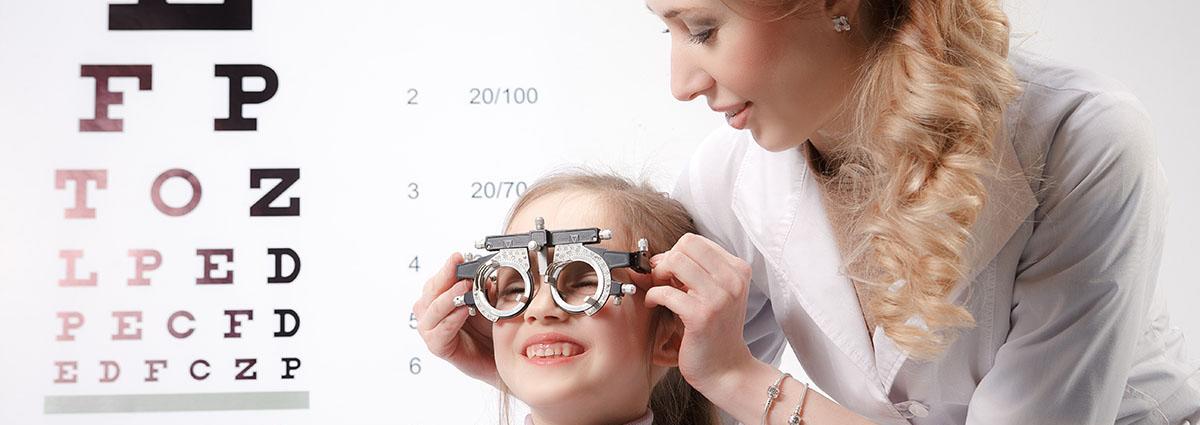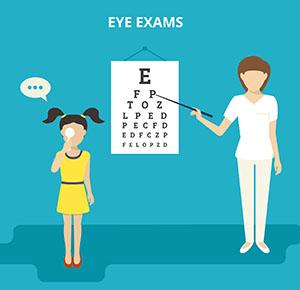Pediatric Eye Care Orlando, Kissimmee, Altamonte Springs
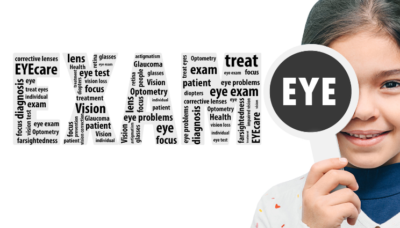
DID YOU KNOW?
85% of the information we obtain is from our sight. Because of this, our vision is crucial in our learning, no matter our age.
It is crucial for children to receive pediatric eye care with an exam before or around the child’s first birthday. The difficulty with pediatric eye care is that children are going to have difficulty vocalizing any vision issues they might have.
A child will not always understand the differences between clear or blurry vision until the child is older. By scheduling regular eye exams, parents can ensure that their children receive the proper vision care they need.
A Customized Pediatric Exam tailored for your child
Dr. Do & Dr. Huynh tailor the pediatric exam based on a child’s age, development and any special needs. The pediatric exam consists of 4 parts:
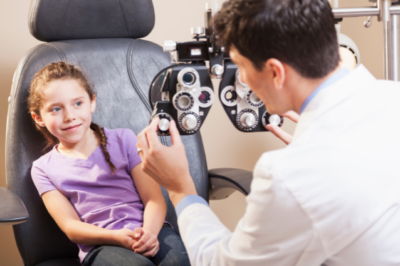
Kid in a Phoropter
- Eye alignment Consists of various tests to look for an eye turn, which can cause a “lazy” eye.
- Color & 3D As this portion relies on your child knowing & being able to vocalize shapes & numbers, it may not be age or developmentally appropriate for your child
- Vision Evaluating your child’s vision using a vision chart & assessing whether your child needs a prescription to see 20/20. We tailor this portion of the exam to your child’s age & development, we have different vision charts & methods to check.
- Health Evaluate the health of the front & interior of the eyes to screen for sight threatening conditions.
Catch the signs early on
Parents who bring their child in for eye examination early in life will be able to help identify any vision issues. People may not realize that the eyes rely on muscles and the level of vision will change as the child ages. Since the child’s eyes are still in development at a young age, vision can change over time. We recommend that children, 1 year old to 3 years old have a Toddler Vision & Health Exam. We recommend that children, 5-years-old and up, have a yearly Pediatric Vision & Health Exam to ensure that their vision is developing properly. There are multiple signs that a child is having difficulty seeing that include:- Squinting to see at distances
- Having difficulty seeing the board from the back of the classroom
- Any head turns
- Frequent headaches
- Constantly rubbing the eyes
- Extreme sensitivity to light
- Poor focus and visual tracking
- Chronic redness or tearing of the eyes
- Difficulty reading
- Sitting too close to the TV
Baby’s Visual Development Milestones
Your baby’s development & learning can be affected if he / she cannot see well. By 5 months, you will notice your baby’s eyes will look straight for several minutes at a time. By 7 months, your baby will be able to follow objects with both eyes at distance and near. By 10 months, your baby should recognize family faces, look at & reach for small objects. *Obtained from Prevent Blindness. https://nationalcenter.preventblindness.org/wp-content/uploads/sites/22/2020/05/2019_PB95_Newborn.pdfRecommended treatment of pediatric eye care

Toddler Ava
For children under the age of 10, glasses are the typical treatment option to help correct vision. While surgery is a possible form of treatment for some eye conditions, it is only necessary in extreme cases. It is much more cost-efficient and healthy to use corrective lenses for regular vision issues instead of surgery when surgery is not necessary.
For children who seem to be against wearing glasses, letting them pick out the frames can help. Parents can look for any plastic frames that are more durable than metal frames. While even younger children can be responsible with their glasses, accidents happen, especially with children. Children who are around 8-years-old or older may be able to wear contact lenses if they can follow all of the necessary steps.
Since one has to insert, remove and clean contact lenses on a regular basis, glasses are a preferable option until children are older. There are even forms of glasses lenses that are more durable than normal and can survive scratches, drops, and damage.
Another benefit of receiving pediatric eye care from a professional office, such as our office, is that our team is patient with children. We have the skills and understanding to treat a child’s eyes and keep them comfortable during the process. During the first consultation, one of our professionals will be able to determine the best treatment option for your child’s vision.
My child’s prescription is always increasing
Pediatric Affiliations / Community
Dr. Huynh was invited to be part of Florida State University’s Low Vision Initiative program in 2022. The program provides a free low vision exam & appropriate tools (magnifiers, telescopes) to children so that visual access to information is not an obstacle in the way of learning. EYE Invision became a sponsor of Union Park Little League Baseball in 2022. We believe in outdoor sports time for many reasons, including promoting team work skills, good health & vision!COMING SOON
Kids, Vision & SportsSee Clearly, Live Freely: Why Children Need to See Clearly
Are you Squinting to See Far Away?
Do you or your child squint to see the whiteboard at school? Maybe struggling to read distant signs has become a common complaint. If so, your child might have myopia, commonly known as nearsightedness. While glasses and contacts can correct vision, a revolutionary approach called myopia control can help slow the progression of this condition.
What is Myopia?
Myopia occurs when the eyeball elongates slightly, causing distant objects to appear blurry. It’s a common condition, affecting nearly half of all children by the age of 18. While glasses and contacts offer immediate relief, they don’t address the underlying cause of the problem.
Myopia Control Orlando, Oviedo, Lake Nona, FL
Myopia has increased due to the increased time spent indoors & on electronics.
Myopia is no longer just a nuisance that involves getting new glasses or contacts every year. We are now seeing it as it truly is – a pandemic. More people now are nearsighted than 100 years ago, and the percentage keeps growing. It is also certain that high myopia increases the risk of other eye- and sight-threatening conditions, including glaucoma and retina detachments. It is imperative that we stop the progression now that we can. https://www.who.int/blindness/causes/MyopiaReportforWeb.pdf
Why Choose Myopia Control?
Here’s why myopia control might be the right choice for your child:
- Slows Progression: Myopia control methods can significantly slow down the worsening of nearsightedness. This can help your child maintain good vision for longer, potentially reducing their dependence on corrective lenses in the future.
- Reduces Risk of Future Eye Problems: High myopia is linked to an increased risk of serious eye conditions later in life, such as retinal detachment and glaucoma. Myopia control can help decrease the chances of developing these issues.
- Provides Clearer Vision: Slower progression of myopia translates to clearer vision throughout childhood, allowing your child to participate fully in activities and learning without blurry distractions.
